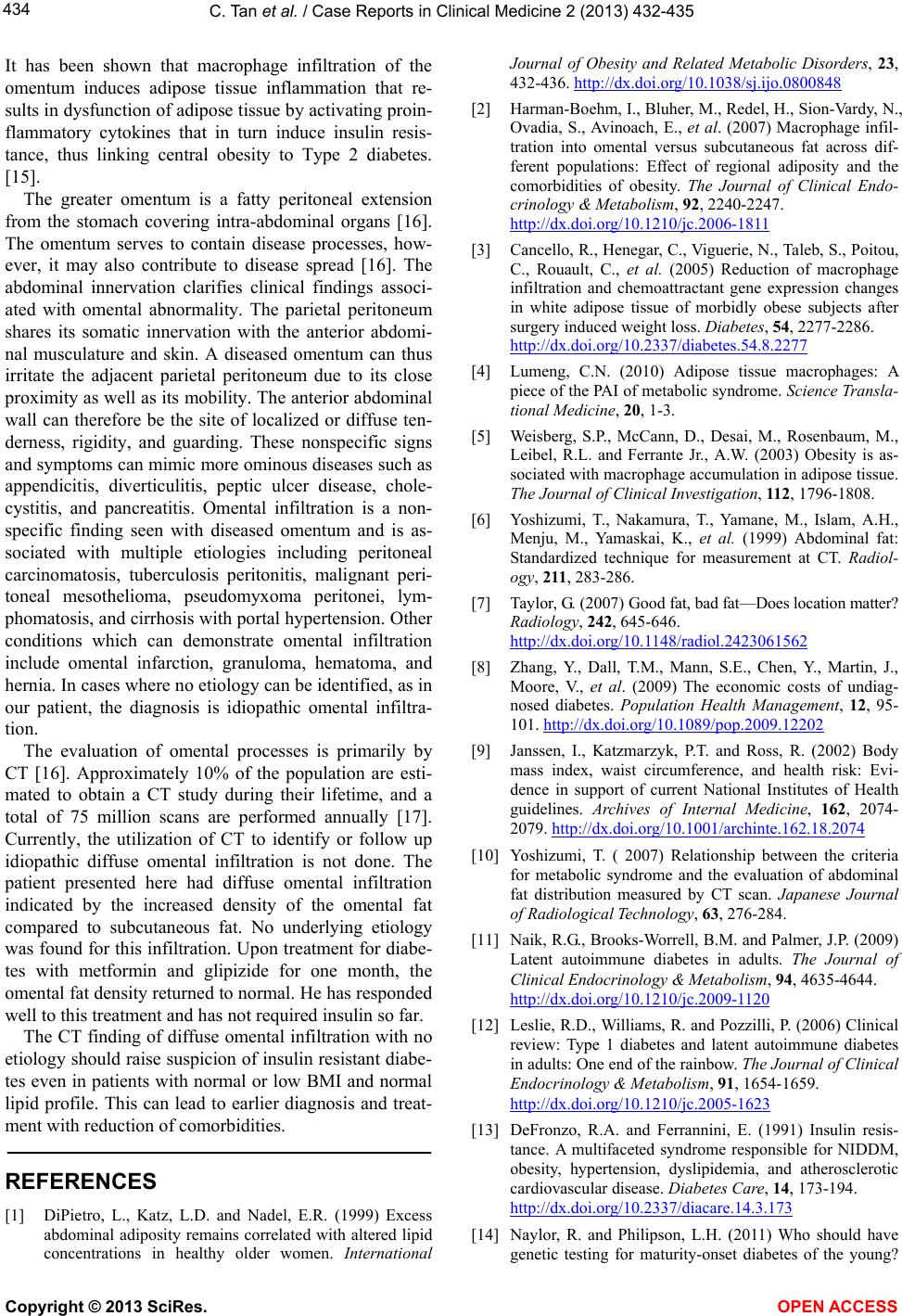
C. Tan et al. / Case Reports in Clinical Medicine 2 (2013) 432-435
Copyright © 2013 SciRes. OPEN ACCESS
434
It has been shown that macrophage infiltration of the
omentum induces adipose tissue inflammation that re-
sults in dysfunction of ad ipose tissue by activatin g proin-
flammatory cytokines that in turn induce insulin resis-
tance, thus linking central obesity to Type 2 diabetes.
[15].
The greater omentum is a fatty peritoneal extension
from the stomach covering intra-abdominal organs [16].
The omentum serves to contain disease processes, how-
ever, it may also contribute to disease spread [16]. The
abdominal innervation clarifies clinical findings associ-
ated with omental abnormality. The parietal peritoneum
shares its somatic innervation with the anterior abdomi-
nal musculature and skin. A diseased omentum can thus
irritate the adjacent parietal peritoneum due to its close
proximity as well as its mobility. The anterio r abdominal
wall can therefore be the site of localized or diffuse ten-
derness, rigidity, and guarding. These nonspecific signs
and symptoms can mimic more ominous diseases such as
appendicitis, diverticulitis, peptic ulcer disease, chole-
cystitis, and pancreatitis. Omental infiltration is a non-
specific finding seen with diseased omentum and is as-
sociated with multiple etiologies including peritoneal
carcinomatosis, tuberculosis peritonitis, malignant peri-
toneal mesothelioma, pseudomyxoma peritonei, lym-
phomatosis, and cirrhosis with portal hypertension. Other
conditions which can demonstrate omental infiltration
include omental infarction, granuloma, hematoma, and
hernia. In cases where no etiology can be identified, as in
our patient, the diagnosis is idiopathic omental infiltra-
tion.
The evaluation of omental processes is primarily by
CT [16]. Approximately 10% of the population are esti-
mated to obtain a CT study during their lifetime, and a
total of 75 million scans are performed annually [17].
Currently, the utilization of CT to identify or follow up
idiopathic diffuse omental infiltration is not done. The
patient presented here had diffuse omental infiltration
indicated by the increased density of the omental fat
compared to subcutaneous fat. No underlying etiology
was found for this infiltration. Upon treatment for diabe-
tes with metformin and glipizide for one month, the
omental fat density returned to normal. He has responded
well to this treatment and has no t required insulin so far.
The CT finding o f diffuse omental infiltration with no
etiology should raise su spicion of insulin resistant diabe-
tes even in patients with normal or low BMI and normal
lipid profile. This can lead to earlier diagnosis and treat-
ment with reduction of comorbidities.
REFERENCES
[1] DiPietro, L., Katz, L.D. and Nadel, E.R. (1999) Excess
abdominal adiposity remains correlated with altered lipid
concentrations in healthy older women. International
Journal of Obesity and Related Metabolic Disorders, 23,
432-436. http://dx.doi.org/10.1038/sj.ijo.0800848
[2] Harman-Boehm, I., Bluher, M., Redel, H., Sion-Vardy, N.,
Ovadia, S., Avinoach, E., et al. (2007) Macrophage infil-
tration into omental versus subcutaneous fat across dif-
ferent populations: Effect of regional adiposity and the
comorbidities of obesity. The Journal of Clinical Endo-
crinology & Metabolism, 92, 2240-2247.
http://dx.doi.org/10.1210/jc.2006-1811
[3] Cancello, R., Henegar, C., Viguerie, N., Taleb, S., Poitou,
C., Rouault, C., et al. (2005) Reduction of macrophage
infiltration and chemoattractant gene expression changes
in white adipose tissue of morbidly obese subjects after
surgery induced weight loss. Diabetes, 54, 2277-2286.
http://dx.doi.org/10.2337/diabetes.54.8.2277
[4] Lumeng, C.N. (2010) Adipose tissue macrophages: A
piece of the PAI of metabolic syndrome. Science Transla-
tional Medicine , 20, 1-3.
[5] Weisberg, S.P., McCann, D., Desai, M., Rosenbaum, M.,
Leibel, R.L. and Ferrante Jr., A.W. (2003) Obesity is as-
sociated with macrophage accumulation in adipose tissue.
The Journal of Clinical Investigation, 112, 1796-1808.
[6] Yoshizumi, T., Nakamura, T., Yamane, M., Islam, A.H.,
Menju, M., Yamaskai, K., et al. (1999) Abdominal fat:
Standardized technique for measurement at CT. Radiol-
ogy, 211, 283-286.
[7] Taylor, G. (2007) Good fat, bad fat—Do es location matter?
Radiology, 242, 645-646.
http://dx.doi.org/10.1148/radiol.2423061562
[8] Zhang, Y., Dall, T.M., Mann, S.E., Chen, Y., Martin, J.,
Moore, V., et al. (2009) The economic costs of undiag-
nosed diabetes. Population Health Management, 12, 95-
101. http://dx.doi.org/10.1089/pop.2009.12202
[9] Janssen, I., Katzmarzyk, P.T. and Ross, R. (2002) Body
mass index, waist circumference, and health risk: Evi-
dence in support of current National Institutes of Health
guidelines. Archives of Internal Medicine, 162, 2074-
2079. http://dx.doi.org/10.1001/archinte.162.18.2074
[10] Yoshizumi, T. ( 2007) Relationship between the criteria
for metabolic syndrome and the evaluation of abdominal
fat distribution measured by CT scan. Japanese Journal
of Radiological Technology, 63, 276-284.
[11] Naik, R.G., Brooks-Worrell, B.M. and Palmer, J.P. (2009)
Latent autoimmune diabetes in adults. The Journal of
Clinical Endoc r i nology & Metabolism, 94, 4635-4644.
http://dx.doi.org/10.1210/jc.2009-1120
[12] Leslie, R.D., Williams, R. and Pozzilli, P. (2006) Clinical
review: Type 1 diabetes and latent autoimmune diabetes
in adults: One end of the rainbow. The Journal of Clinical
Endocrinology & Metabolism, 91, 1654-1659.
http://dx.doi.org/10.1210/jc.2005-1623
[13] DeFronzo, R.A. and Ferrannini, E. (1991) Insulin resis-
tance. A multifaceted syndrome responsible for NIDDM,
obesity, hypertension, dyslipidemia, and atherosclerotic
cardiovascular disease. Diabetes Care, 14, 173-194.
http://dx.doi.org/10.2337/diacare.14.3.173
[14] Naylor, R. and Philipson, L.H. (2011) Who should have
genetic testing for maturity-onset diabetes of the young?